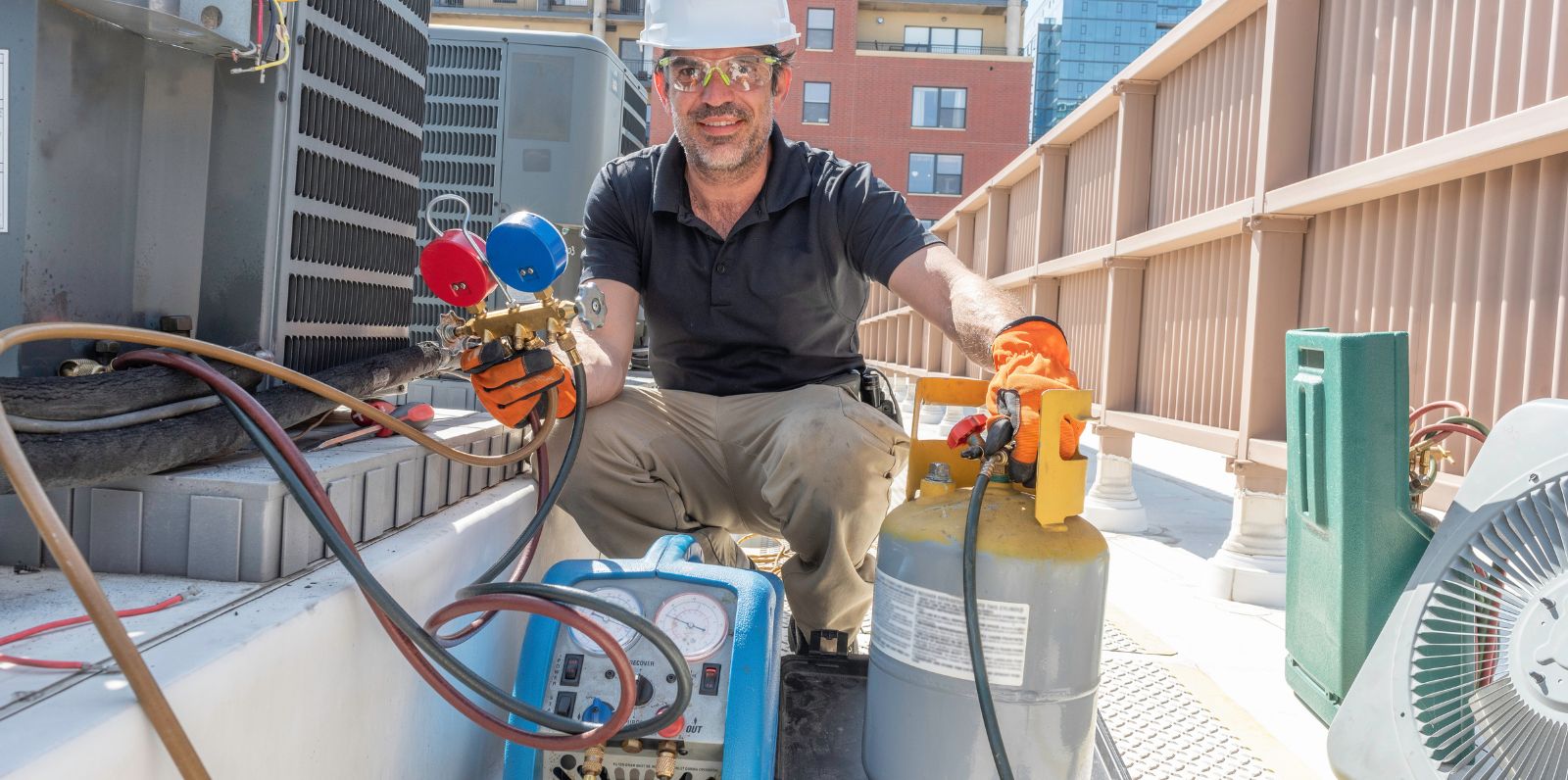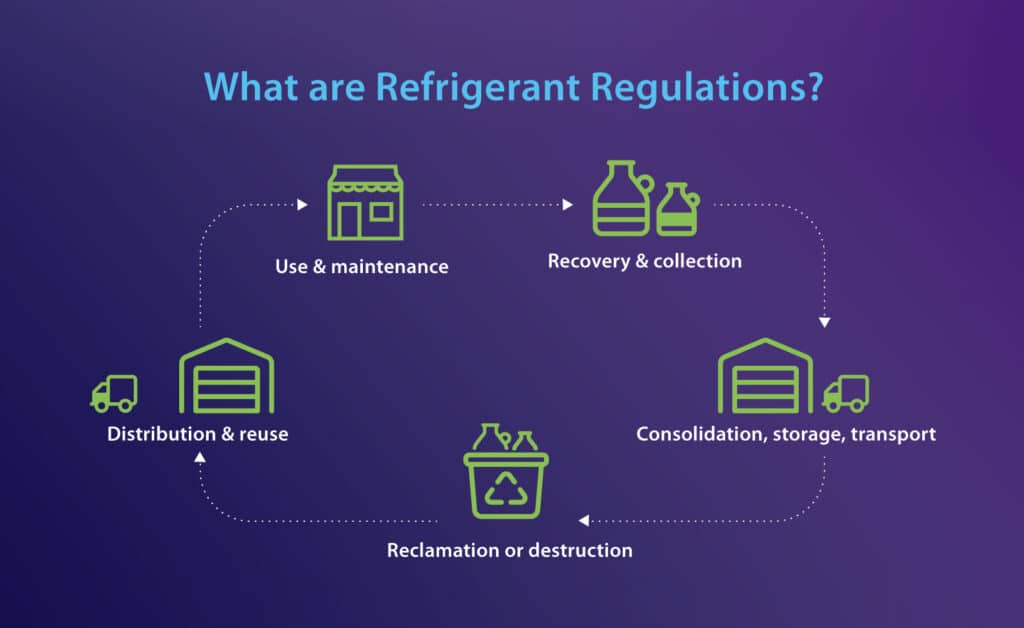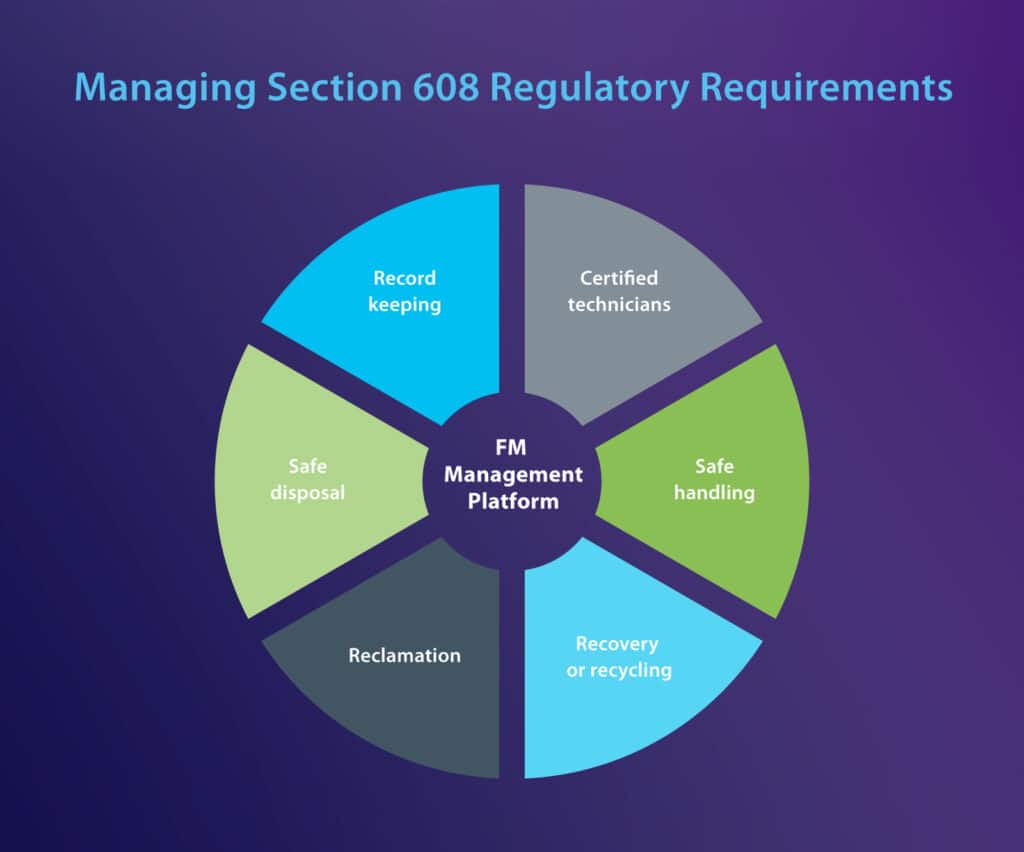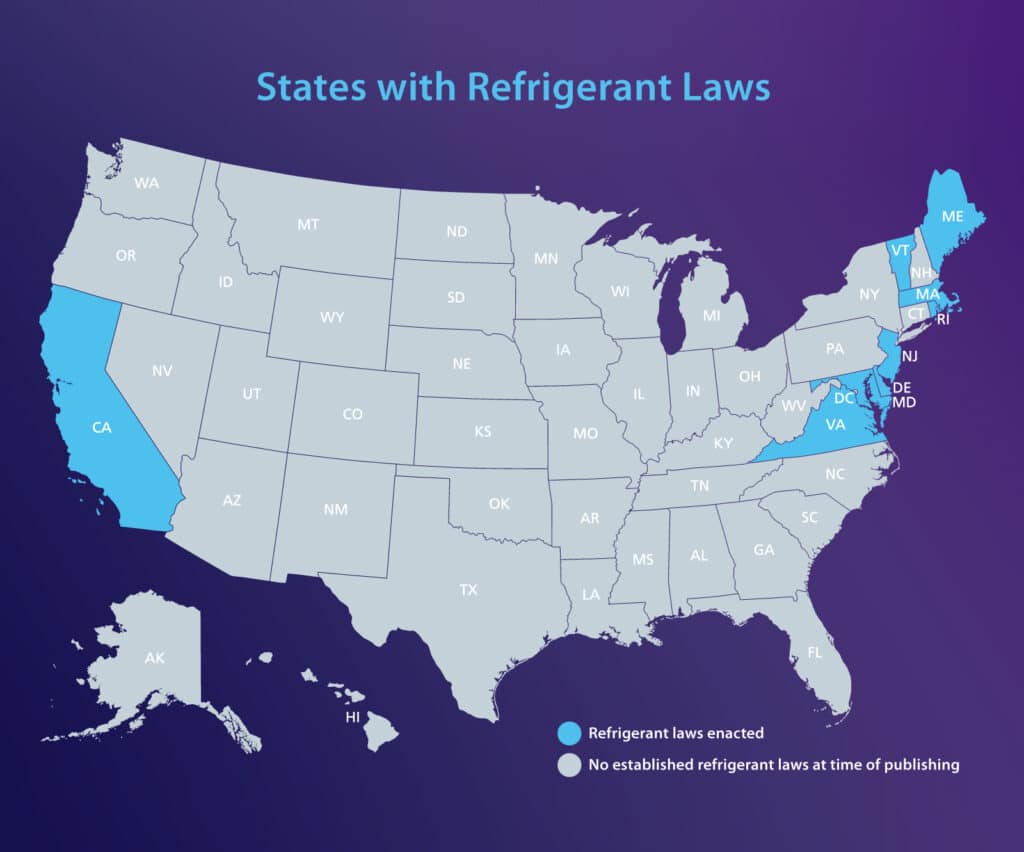What Facility Managers Should Know About EPA Refrigerant Regulations

The refrigerants released from appliances like air conditioners and refrigerators pose a danger to both humans and nature. For that reason, many organizations invest in a platform that captures the rules around the Environmental Protection Agency (EPA) law. That way, they have a way to track the processes in place outlining how technicians should handle refrigerants. In addition, companies avoid putting themselves at risk of getting fined for violations. The ServiceChannel platform helps companies centralize and maintain sustainable refrigeration procedures.

What are Refrigerant Regulations?
Refrigerant regulations are designed by the Environmental Protection Agency (EPA) to address how refrigerants are handled and recycled based on the type of equipment being used. There are currently four certification classifications: small appliances, high and very high pressure, low pressure, and universal.
EPA refrigerant regulations are outlined in detail under Section 608 of the Clean Air Act. They are important for people or businesses to prevent them from knowingly and willingly venting refrigerants that harm the ozone layer. These regulations also provide standards on how technicians should handle these refrigerants while conducting repairs, service calls, maintenance, and disposal of refrigeration and HVAC equipment.
Updates to these regulations will take place in 2024 when six A2L (low-flammable) refrigerant alternatives are allowed for use in new residential and light commercial air conditioners and heat pumps.

How to Manage Refrigerant Equipment
The EPA regulations for refrigerant management and air conditioning equipment outlines how companies can avoid releasing ozone-depleting substances (ODS) from appliances. They also maximize the ability of stationary equipment to recapture and recycle the substance. Keeping up with the compliance guidelines also helps ensure technicians properly dispose of ODS.
Below are additional details on managing refrigerant equipment, including venting and releasing, as outlined by the EPA.
Venting Refrigerants
Although adhering to the EPA regulations is mandatory, there are instances where it is necessary to vent a refrigerant. This is done by a licensed technician who knows the rules and takes every precaution in following them.
Companies are only allowed to release refrigerant under the following circumstances:
- Release the minimum amount required to run equipment. However, businesses must make a good-faith attempt to recapture the refrigerant, recycle it, or dispose of the ODS. That includes releases that happen when a technician connects or disconnects hoses when charging or servicing appliances.
- Run air conditioning and refrigeration equipment during normal air conditioning and refrigerant operations, which can happen from leaks and mechanical purging. However, companies must repair leaks of a certain size that occur in equipment containing at least 50 pounds of refrigerant.
- Release substitutes that don’t pose an environmental threat based on an evaluation by the EPA.
Servicing Refrigerant Requirements
When equipment needs servicing, the laws are clear for refrigerant management. There must be specific records kept for commercial refrigeration equipment, and those records must be kept and readily available for inspection for three years from the date of servicing.
Appliances containing more than five pounds of refrigerant
When technicians open equipment to perform maintenance, servicing, repairs, or disposal, they must evacuate the refrigeration and air conditioning equipment to establish vacuum levels.
Appliances containing five pounds or less of refrigerant
When technicians handle small appliances, they must recover 80% of refrigerant when:
- Recovering or recycling equipment made before November 15, 1993
- Dealing with an appliance with a non-functional compressor
Technicians must capture 90% of refrigerant when:
- Recovering or recycling equipment made after November 15, 1993
- Dealing with an appliance with a functional compressor
Leak Repair Requirements
Leaks have a detailed process, including calculating the leak rate for the equipment every time refrigerant is added. When a leak is found, the repair must be completed within 30 days on commercial applications. If the leak is within industrial process refrigeration, the repairs must take place within 120 days. Any appliances with leak rates over 125% of their full charge for a period of 12 months must be reported to the EPA by March 1 of the following year, along with how the leak was identified and steps taken to repair it.
When equipment needs servicing, the laws are clear for refrigerant management. There must be specific records kept for commercial refrigeration equipment, and those records must be kept and readily available for inspection for three years from the date of servicing.
Owners and operators of appliances containing a full charge of 50 or more pounds of refrigerant with an ODS leak must perform repairs when the trigger rates hit the following during a 12-month period:
- Industrial process refrigeration — 30%. Typically applies to complex customized applications directly linked to processes for a business in industries like petrochemical, pharmaceutical, and manufacturing.
- Commercial refrigeration — 20%. Typically applies to refrigeration appliances used in warehouses that hold retail food and cold storage items. That includes those used in convenience stores, supermarkets, and restaurants.
- Comfort cooling — 10%. Typically applies to air conditioners that help control heat or humidity in facilities like offices, residences, and commercial buildings.
Maintaining Regulatory Compliance
The primary reason for the implementation of the Clean Air Act is to protect the ozone layer from ODS toxins. For that reason, the EPA can enforce various penalties to companies found to be in violation of the regulations, which can include everything from civil fines to a criminal prosecution.
Typically, the EPA confiscates any equipment found to be violating the EPA act. In addition, the agency also confiscates any illegally imported equipment that fails the refrigeration standards. Owners assume responsibility for running any equipment that does not fall in line with the EPA’s regulations under Section 608.
Section 608
Section 608 of the Clean Air Act prohibits anyone from releasing refrigerant into the air while servicing, repairing, performing maintenance on, or disposing of any air conditioner or refrigerator equipment. That’s because the toxic nature of refrigerants can lead to poisoning. They also affect the environment by eating away at the ozone layer.
The requirements in this section also state that technicians must be certified under this section of the Clean Air Act. Once that happens, they can only purchase refrigerants required to run appliances covered under their certification. In addition, technicians cannot resell recovered refrigerant unless:
- It gets reclaimed by a certified reclaimer
- It gets transferred to equipment that belongs to the same owner
- It’s only use was in a motor vehicle air conditioner or MVAC-like appliance before getting recycled
Certified technicians must pass a certification exam provided by an approved technician certification program before handling refrigerants. They’re required to keep a copy of the certification at their place of business. In addition, technicians must maintain the certification for three years past the time they stop operating as a technician.
Technicians that dispose of mid-sized appliances must keep records of the following:
- Location, recovery date, and refrigerant type of each appliance
- Quantity of refrigerant and the type recovered from appliances by month
- Quantity of refrigerant, the type, any transfers for reclaiming or destruction, the person who took ownership, and the transfer date
All technicians must evacuate refrigerant before they open and dispose of appliances to meet the levels specified in certification recovery of or recycling of equipment.
Section 608 of the Clean Air Act, managed by the Environmental Protection Agency (EPA) prohibits anyone from releasing refrigerant into the air while servicing, repairing, performing maintenance on, or disposing of any type of air conditioner or refrigerator equipment. That’s because the toxic nature of refrigerants can lead to poisoning. They also affect the environment by eating away at the ozone layer.
Because refrigerants pose such a danger to humans and nature, it’s imperative that organizations have processes in place that outline the proper procedures of how technicians should handle refrigerants. For that reason, many organizations invest in a platform that captures the rules around the EPA law. That way, they avoid putting themselves at risk of getting fined for violations.
HFC Refrigerant Allowance
As of September 23, 2021, the EPA issued a final rule called “Phasedown of Hydrofluorocarbons: Establishing the Allowance Allocation and Trading Program under the American Innovation and Manufacturing (AIM) Act.” The law calls for the EPA to focus on phasing down the production and consumption of hydrofluorocarbons (HFCs), which are super greenhouse gasses used in refrigeration.
Based on that rule, the U.S. must cut down on HFC consumption by 85% over the next 15-years. The goal in calling for a global HFC phase down is to keep global warming from increasing by 0.5 degrees Celsius by 2100.
In addition, the rule sets baseline levels for how the reduction should occur along with an initial methodology to calculate how to allocate and trade HFC allowances for the years 2022 and 2023. The rule also outlines a compliance and enforcement system for the rule.
Disposing of Refrigerant
EPA refrigerant regulations have detailed instructions on how to safely dispose of refrigeration and air-conditioning equipment, including dismantling on-site prior to disposal. In most cases, if the refrigerant is not contaminated, it can be reused or recycled. If an appliance is being recycled, a licensed technician must remove the refrigerant.
Any company disposing of refrigeration and air conditioning equipment that usually gets dismantled on site must recover refrigerant according to the servicing requirements outlined by the EPA. In addition, equipment like motor vehicle air conditioners and household refrigerators that generally enter the waste stream intact must follow special safety disposal requirements as follows:
- The entity at the end of the disposal chain, like a scrap metal recycler, has final responsibility for recovering refrigerant before disposal.
- If the final entity accepts an appliance without a refrigerant charge, they must obtain a statement from the person who dropped off the appliance confirming that it was empty. The notice should include the drop-off person’s name and address and the date of the refrigerant recovery.
- The entity at the end of the disposal chain can enter a contract with a regular commercial supplier who specifies how they will recover the refrigerant or verify recovery before delivery.
Keep in mind that the EPA does not allow a sticker form of refrigerant recovery before disposal. Anyone recovering refrigerant from a small appliance or MVACs does not have to be a certified technician.
However, equipment used for refrigerant recovery from an appliance before disposal must meet the standards outlined for refrigerant recovery equipment used for servicing.

States with Refrigerant Laws
These states are aligned with federal EPA SNAP Rules 20 and 23, prohibiting certain HFCs in some stationary refrigeration and air-conditioning end users. These additional laws may affect facilities managers.
New Jersey
New Jersey enacted A-5583, effective July 1, 2020, along with new inventory and reporting requirements for refrigerants under the Greenhouse Gas Monitoring and Reporting Rule in June 2022.
California
California is designated SNAP Plus, enacting SB 1013, effective January 1, 2019, but also has Global Warming Potential (GWP) thresholds for new and existing food retail facilities starting January 1, 2022. As of August 2022, there are additional regulations under SB 1206.
Delaware
Delaware enacted 7 DE Admin Code 1151, effective September 1, 2021.
Maine
Maine enacted HP 161, effective January 1, 2022.
Maryland
Maryland enacted COMAR 26.11.33 as of January 1, 2021.
Massachusetts
Massachusetts enacted 310 CMR 7.76 effective January 1, 2021.
Rhode Island
Rhode Island enacted 250-RICR-120-05-53, effective January 1, 2022.
Vermont
Vermont enacted S.30, effective January 1, 2021.
Virginia
Virginia enacted 9VAC5 Chapter 145, enacted January 1, 2022.
Maintaining EPA Refrigerant Regulations in Your Facility
Businesses must abide by the rules outlined by the EPA to avoid any penalties or criminal charges. Learn more about how our solution can help facility managers remain compliant and address other facility management issues by exploring ServiceChannel for compliance and risk .



